February 2025










Home office essentials
The global COVID-19 pandemic opened people’s eyes to many things. One of the more lasting impressions was how the traditional workplace environment was not as essential as people once thought. Millions of people pivoted to remote work during the pandemic, and a significant percentage of those individuals continue to work from home.
Remote work is now common in many industries. According to an Upwork study, 22 percent of the American workforce will be remote by 2025. The Pew Research Center says around 22 million employed adults (ages 18 and over) in the United States work from home all the time, which is equal to about 14 percent of all employed adults. Statistics Canada said 18.7 percent of Canadian workers worked mostly from home in May 2024.
Homeowners are increasingly outfitting their homes with spaces that can accommodate working from home. Maximizing a home office with essentials comes down to some key components.
Superior PC or laptop
Chances are that it will be nearly impossible to get any work done without a computer. Most people have devices at home,
but it’s best to check with employers to see which kind of specifications would be needed in a machine to run the types of applications that keep the business functioning. An older laptop or PC might need to be upgraded to a newer, more powerful model.
Reliable internet connection
Connectivity is vital when working from home. Remote workers must be accessible via email, and many companies rely on messaging applications or VoIP (voice over internet protocol) telephone systems. Those who have been considering an upgrade to bandwidth and internet speed may want to take the plunge if they expect high volume of data uploads and downloads and constant connectivity. Experts advise a minimum of 100 Mbps download speed and 10 Mbps upload speed as a good starting point for remote work.
Ergonomic desk and chair
Remote workers can outfit a home office with furniture that’s customized to their needs, rather than what would just be provided in a traditional office setting. One item to consider is a convertible desk, which can be raised or lowered to accommodate
sitting or standing at a workstation. No home office is complete without a comfortable chair. Choose a chair with lumbar support and adjustability.
Laptop stand
A laptop stand can help a person avoid a condition called “tech neck,” which the Mayo Clinic describes as being caused from poor posture while using technology. Instead of looking down at the laptop, the stand will raise the device to a proper eye level. Use a wireless keyboard and mouse to make it even more comfortable and convenient.
Noise-cancelling headphones
Many times a home office is tucked into whatever nook in the house is available. That may mean it is adjacent to a living room or the kitchen in the midst of the hustle and bustle. Things can get noisy, and a pair of quality noise-cancelling headphones can help mitigate ambient sounds.
Remote work continues to gain steam and home offices need to meet the demands of working from home.
Considerations for your second act
Many people see their careers as one of their defining characteristics. Children are often asked what they want to be when they grow up, and as adults they will likely be asked “What do you do for a living?” more times than they can remember. Work is undoubtedly a major component of life for most people from the time they leave school to the day when they retire. And a growing number of adults value work so much that they pivot to second careers.
A phenomenon known as “unretirement” occurs when people who have previously retired return to the workforce. A 2010 paper published in the Journal of Human Resources found nearly 50 percent of retirees followed a nontraditional retirement path that involved partial retirement or unretirement. According to a recent Retirement Saving & Spending Study from T. Rowe Price, around 20 percent of retirees are working either full- or part-time, while 7 percent of study respondents are looking for employment. Some people return to work for financial reasons while others seek the social and emotional benefits employment can
bring. But individuals mulling a return to work or those currently working but trying to determine a second act should not feel beholden to previous career paths. A second trip around the employment block can involve an entirely different line of work. The following are some things to look for in a second act.
• Flexibility: Choose a career path that enables you to set your own schedule or possibly work part-time if that is your preference. This way you can still reap some of the benefits of retirement, including the flexibility to travel.
• Social interaction: Adults may lose daily opportunities to be social when they retire, which can compound feelings of isolation common among retirees. Consider a second career that lets you interact with a number of people and continue to build relationships and a good network.
• Personal passions: Reflect on what you
might do for work if money were no object. This may help you narrow down new opportunities that are in line with your interests and passions. Find a job that utilizes your skills and experience and meshes with your interests. A former graphic artist, for example, may decide to teach design to young people.
• Nonprofit opportunities: Many retirees spent years in high-stress corporate environments where bottom lines may be more important than the bigger picture. Shifting to a career in the nonprofit sector can be a personally fulfilling job that utilizes skills learned in the corporate world.
• Consulting or contract work: If you’re a retiree who loved your job, you might want to have a second career as a consultant or contractor in the same field.
A number of retirees ultimately explore second careers. Finding a match may be easier than one could have imagined.




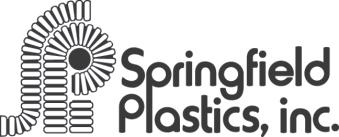
Springfield Plastics, Inc. Expansion Bringing 65 New Jobs to Auburn
After breaking ground in April 2023, Springfield Plastics’ 63,000-sq.-ft. building expansion in Auburn, Illinois, should be completed soon. Along with the expansion, Springfield Plastics will be hiring for as many as 65 new full-time positions.
“We are excited to begin this new era at Springfield Plastics,” said Steve Baker, President of Springfield Plastics. “Our board, executive team, and staff have been working tirelessly to put this plan in place and bring a disciplined approach to our growth plans.”
Tremendous growth in the agricultural industr y, specifically within the tile drainage industr y, has led to this new construc tion.
Over the past several years, Springfield Plastics has expanded to deliver its 100%-virgin-resin made produc t to a nine -state area and added a second location in Humboldt, Iowa, to ser vice customers far ther to the nor th and west The company is also building a new distribution facility in Nor th Manchester, Indiana. To accommodate these growth plans, staff additions are expec ted in customer ser vice, sales, shipping, accounting, engineering, and manufac turing
“Our customers have come to expec t a high level of ser vice from our committed front-line and suppor t staff,” said Jennifer Furkin,
Vice President of Springfield Plastics. “By adding depth to nearly ever y depar tment, we will be able to provide that same ser vice to more customers across a larger geographic area.”
Produc tion of Springfield Plastics tile and fittings is handled at the Auburn location. New and expanded areas that will be par t of this growth plan include produc tion, raw materials, management, quality control and assurance, and warehousing. To get the new Auburn location off to a successful star t, Springfield Plastics is currently hiring customer ser vice representatives, engineers, accounting staff, fac tor y workers, janitors, and maintenance workers.
“Having the expanded manufac turing capabilities along with implementing even newer technologies will allow for significant growth in our produc tion capacity,” said Furkin. “Our new facilities and staff additions to operate them will fold seamlessly into our continued commitment to provide more produc t on time to our loyal and new customers.”
A histor y of success
Springfield Plastics is a leading Midwest manufac turer of corrugated plastic drainage pipe. In 2000, the company became the sole U.S. manufac turer cer tified as using only 100% virgin material in its drainage pipe.
“ This company began with a few simple thoughts,” said Baker. “A commitment to manufac turing the best produc t on the market, delivering a high level of ser vice to our customers, and a steadfast dedication to our employees and the communities in which we operate For ty-five years later I can say with confidence that these are still our guiding principles ”


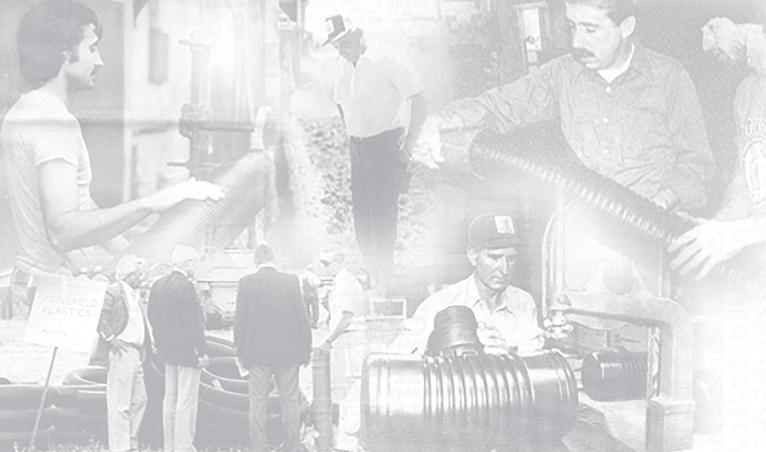
NO W HIRING
Springfield Plastics is currently looking to fill several full-time positions. To learn more, see job openings, or apply for a job, visit


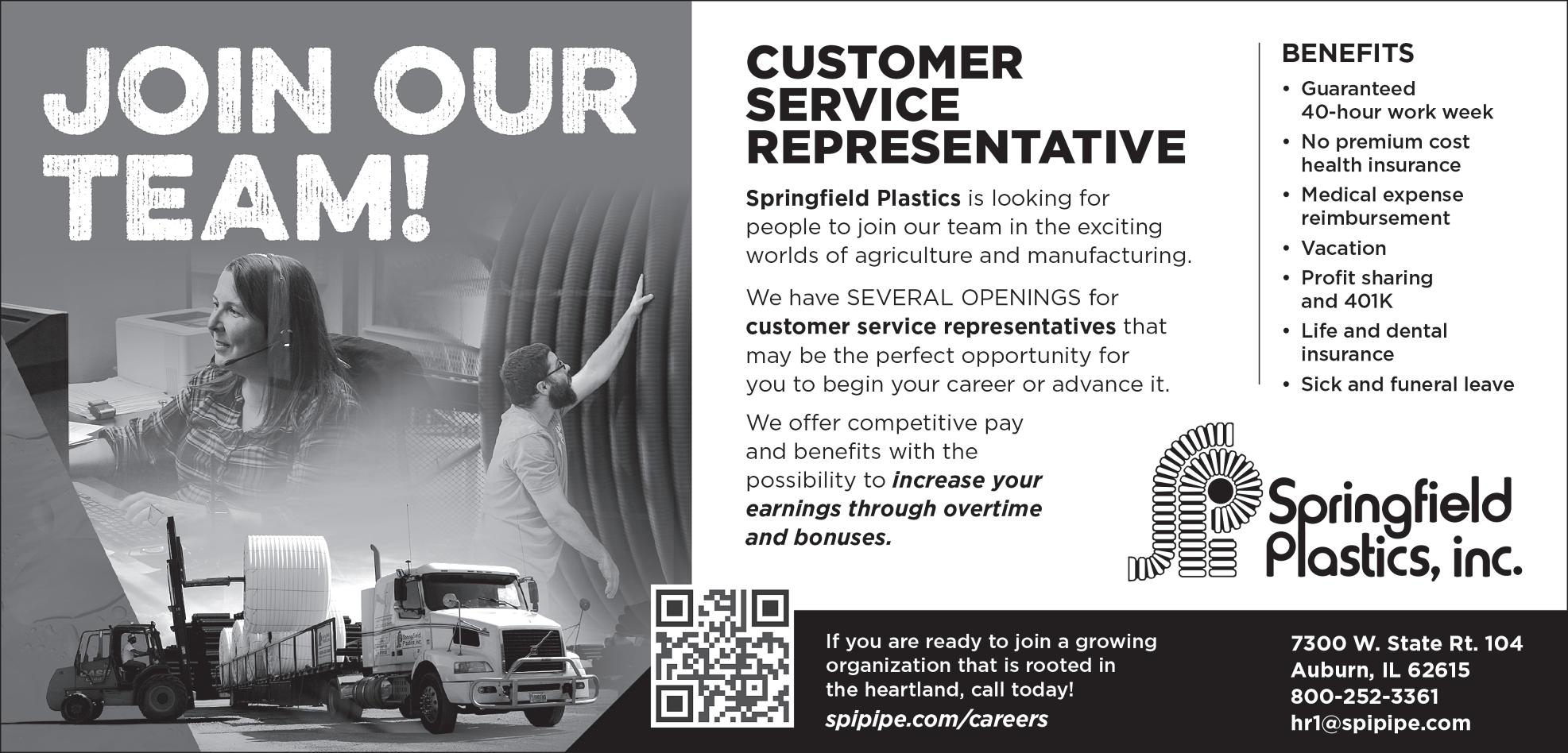
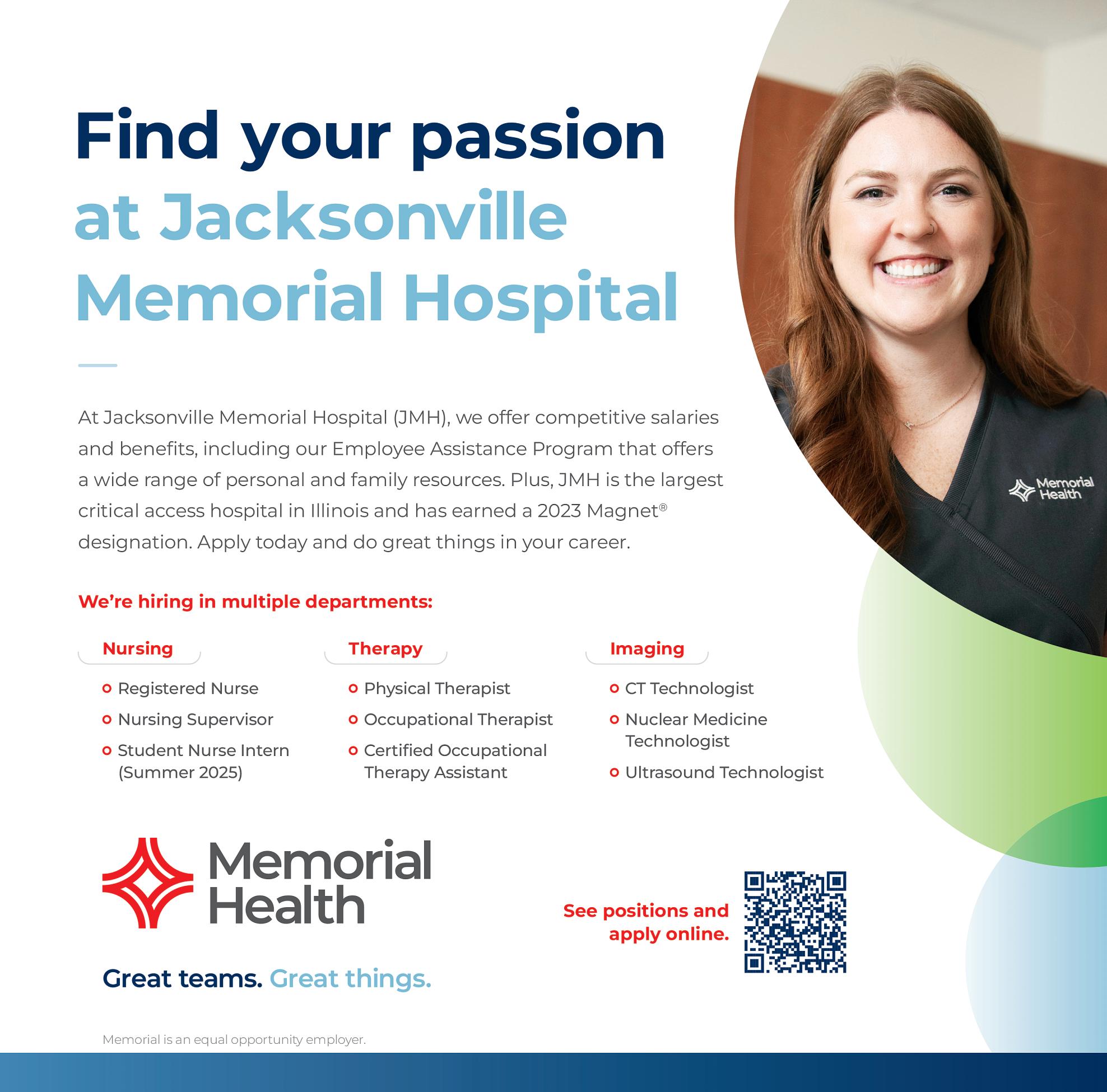

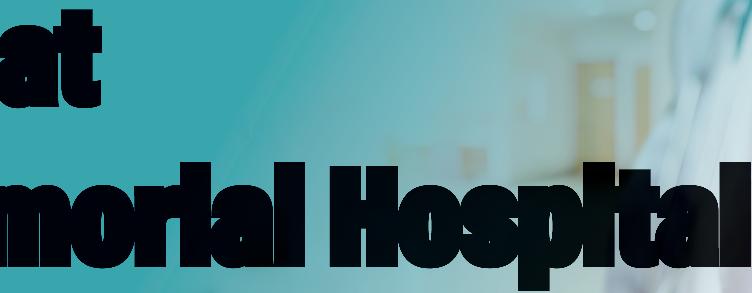
Make an Imp act mp at Jack sonville Memorial Ho spi t al
For nearl y 150 years , Jack sonville Memorial Ho spital (JMH) has been a trusted healthcare provider, delivering compas sionate , highqualit y care to Brown, Cas s , Greene , Morgan and Scott countie s . A s a critical acce s s ho spital, we ensure familie s in our communit y have acce s s to advanced healthcare clo se to home.
At JMH, our mis sion is personal we are neighbors caring for neighbors . Whether through emergenc y care , rehabilitation, imaging or bedside nursing, our team make s a lasting impac t e ver y day. Our dedication to excellence has earned us :
• Magnet® Recognition for Nursing E xcellence – held by onl y 2% of ho spitals nationwide
• Accreditation by The Joint Commis sion – a te stament to our high standards of patient care
• Membership in the AHA , I HA and VHA – keeping us at the fore front of healthcare innovation
“ When you step into Jack sonville Memorial Ho spital, you’re not just star ting a job —you’re joining a team that pu t s people f irst , ” said Tre vor

Huffman, pre sident and CEO of JMH. “Our colleague s are pas sionate abou t their work , and that pas sion translate s into better care for our communit y. ”
Why Choose Jacksonville Memorial Hospital?
E xceptional care star t s with exceptional people. That ’s why we offer :
• Competitive pay and bene f it s to suppor t your well-being
• Educational as sistance and tuition reimbursement for career grow th
• A clo se -knit , team-focused culture where collaboration is valued
• Flexible scheduling options to suppor t work-li fe balance
From new graduate s to experienced profe s sionals , we provide oppor tunitie s to grow, lead and make a di fference.
Find Your Purpose at JMH
At Jack sonville Memorial Ho spital, e ver y role matters . Whether you provide direc t patient care , clinical suppor t or help behind the scene s , your work has a meaningful impac t
on our communit y.
Allied health profe s sionals are at the core of patient diagno stic s and treatment . Imaging spec ialist s , lab technic ians , surgical techs and pharmac ist s deliver the exper tise that guide s care dec isions and improve s ou tcome s . Meanwhile , suppor t ser vice s teams in environmental ser vice s , food ser vice s , securit y and more ensure a safe , welcoming environment for patient s and staff.
Nurse s , LPNs and nursing as sistant s provide e s sential care acro s s ho spitals and clinic s , while administrative and profe s sional teams in HR , communications , f inance and other areas keep our ho spital running smoothl y.
Acro s s e ver y depar tment , our colleague s share a commitment to excellence , innovation and compas sionate care.
Take the nex t step in your career! E xplore available oppor tunitie s at job s .memorial.health.
At Jack sonville Memorial Ho spital, we don’ t just treat patient s we care for our communit y. Be par t of something bigger. Join us .
Tips to manage time more efficiently
Busy days tend to be productive days. But when especially busy days are strung together, adults can begin to feel a little overwhelmed and may wonder if there’s anything they can do to make hectic schedules more manageable.
Time management strategies can be an effective tool in busy adults’ arsenals. Efficient time management can free up more minutes or hours in the day, which can ultimately afford adults more time to exhale and thus make each day seem a little less overwhelming. Time management may require a little trial and error before adults find a formula that works for them, but the following are some tips to improve personal efficiency each day.
• Identify tasks that can be tackled at night. A hectic start to a morning can set a bad precedent for the rest of the day. With that in mind, adults can identify tasks they can perform at night to ensure mornings are less hectic. Lay out clothes the night before to save the trouble of finding an outfit in the morning. Prepare the family’s lunches and even breakfasts the night before so mornings go more smoothly.
• Exercise in the morning. A recent study from the World Health Organization published in the Lancet Global Health Journal found that 31 percent of adults don’t get enough exercise. Lack of routine physical activity has been linked to a host of negative health outcomes, including an increased risk for conditions like heart disease, diabetes, cancer, and stroke. Adults who exercise at night may find that attempts to squeeze in early evening or nighttime workouts add to feelings of being overwhelmed brought on
by busy schedules. Exercising in the morning can free up time for other tasks in the evening, and doing so can even make it easier to manage daily stress, as the Mayo Clinic reports that exercise in any form releases endorphins and helps to relieve stress.
• Minimize distractions. Distractions are arguably more prevalent than ever, as many adults feel nary a minute goes by without a smartphone notification and/or message from friends, family and coworkers. Minimizing those distractions and resolving to tackle one task at a time can improve efficiency and reduce stress. Turn off smartphone notifications from apps that are not vital to work and family. During the workday, prioritize tasks each day and block off hours on your schedule so time can be devoted exclusively to the most important jobs. If hours on a schedule are left open, coworkers may schedule meetings that can make it difficult to complete necessary tasks.
• Adjust as necessary. Flexibility is a must when making an effort to avoid feeling overwhelmed. Each day presents its own unique and fluid challenges, so remaining flexible can help busy adults overcome unforeseen obstacles. In addition, some time management strategies may not be effective for everyone nor useful every day, so it’s best to recognize the need to adjust from time to time.
Time management strategies can help busy adults efficiently manage each day and hopefully reduce instances when individuals feel overwhelmed.



Tips to protect your eyes in the workplace

Individuals go to work each day to provide for themselves and their families. Working provides many benefits, but it also exposes people to some risks. For some, those risks include eye injuries.
The National Institute for Occupational Safety and Health says about 2,000 workers sustain job-related eye injuries that require medical treatment each year in the United States. According to the Canadian Association of Optometrists, more than 700 eye injuries are reported in Canada every day, and over 200 of those injuries occur in the workplace. Employment-related injuries can be traced to hazards like chemicals, radiation, dust, and flying debris. The U.S. Bureau of Labor Statistics found that almost 70 percent of the accidents studied on the job resulted from flying or falling objects or sparks striking the eye. However, digital eye strain from working on a computer on a daily basis also affects professionals’ eyes.
Preventing eye injuries often comes down to recognition of hazards and what can be done to avoid common injuries. These tips can help.
• Employees should be educated and trained on all dangers specific to the workplace.
• Employers should install barrier and shields in areas prone to flying debris and dust.
• Employees working in hazardous environments should have access to and be


Did you know?
A high cost of living and advancements in medicine that have contributed to longer life expectancies would seemingly compel individuals to work longer, but data indicates the average professional is retiring shortly after turning 60.
Data from the 2024 MassMutual Retirement Happiness Study indicates that the average retirement age among American retirees is 62. That’s in spite of the fact that pre-retirees and retirees who participated in the study indicated that 63 is the ideal retirement age.
wearing eye safety equipment at all times.
• The proper use of eye safety equipment means using the right kind of protection for the job. Forms of eye protection include goggles, safety glasses, face shields, or full face respirators.
• Employees should take breaks when working on the computer. To help alleviate digital eye strain, experts recommend the 20-2020 rule. This means taking a 20-second break to view something 20 feet away every 20 minutes.
• Special filters can protect the eyes from optimal radiation exposure. Filters can be used when welding or working with lasers.
• Employees should recognize that contact lenses can’t provide protection from eye hazards in the workplace. However, contact lenses can provide improved vision in the workplace. According to the American Optometric Association, workers should be allowed to wear contact lenses in most eye-hazardous environments, provided they wear eye protection over the contact lenses.
Prevent Blindness America says 90 percent of all workplace eye injuries can be avoided by wearing proper safety eyewear and following the safety guidelines recommended for each particular industry.

Canadians are staying in the workforce a good deal longer, as Statistics Canada reports the average retirement age across Canada in 2023 was 65.1. That disparity could be due to the Canada Pension Plan (CPP), which replaces part of retirees’ income with a monthly, taxable benefit. The Government of Canada reports the standard age to start the CPP is 65.


Financial tips for young professionals
Young adults confront something of a juggling act once they begin their professional lives. For many, that challenge begins with landing and starting a first job, arranging a payment plan for student loans, finding a place to live, and determining savings and personal finance goals. Although entering the workforce and taking a big step toward financial independence can be exciting, it also comes with financial responsibility.
Setting a strong financial foundation as early as possible helps establish long-term financial security. These tips can help young professionals manage their money more effectively.
• Take a money management course. Young professionals may be tired of heading to class or making the grade at this point in life, but educating oneself about some of the basic rules of personal finance can help bridge knowledge gaps in this arena. Many young adults have never been taught the basics of applying for credit and staying out of debt.
If you’ve been riding your parents’ financial coattails throughout school, now is the time to learn more, whether it’s through an online course or reading up on the subject.
• Set SMART goals. The acronym SMART stands for Specific, Measurable, Achievable, Relevant, and Time-bound, and can serve as a roadmap to achieving various goals, including those related to money. Develop a clear plan for your money, which can make it easier to budget and achieve savings-related goals.
• Minimize debt. The Education Data Initiative says university graduates owe an average of $28,244 on student loans after they leave school, with a monthly payment between $200 and $299. Some graduates have even more debt and higher payments. Managing debt is vital to anyone’s finances. Create a debt repayment plan at the earliest opportunity. With a “snowball” strategy, borrowers pay off their smallest debts
first. Once a debt is paid off, the payment amount for that debt is then applied to the next smallest debt, gaining momentum with each payment. The “avalanche” approach involves paying off the debt with the highest interest rate first.
• Aim to pay with cash more often. Unless you can afford to pay off the balance in full every month, using credit cards a lot can contribute to debt accumulation. LendingTree says that, as of September 2024, the average APR on all new card offers was 24.92 percent. Buying items with cash or debit will reduce the likelihood of spending what you don’t have, offers Investopedia.
• Set up an emergency fund. It might be challenging to set aside a lot of money right now when you have an entry-level position and some debt. But setting aside as little as $1,000 for unexpected life events separate from your own personal savings can shield you from issues that arise from unexpected
expenses.
• Participate in employer benefit plans. Look for the various ways that your employer can help you save money. This may include participating in retirement plans (including those with employer contribution matches), health spending accounts, gym memberships, and additional opportunities.
• Start saving and investing now. According to SmartAsset, if you start investing $150 a paycheck at age 25 and your investments have an average annualized return of 8 percent, after 40 years you’ll have about $1.1 million in your account. Investing the same at age 35 means cutting nearly half of that total simply by procrastinating.
There are many ways young professionals can develop strong financial skills. Working with a certified financial planner also can help young professionals grow wealth over the course of their lives.

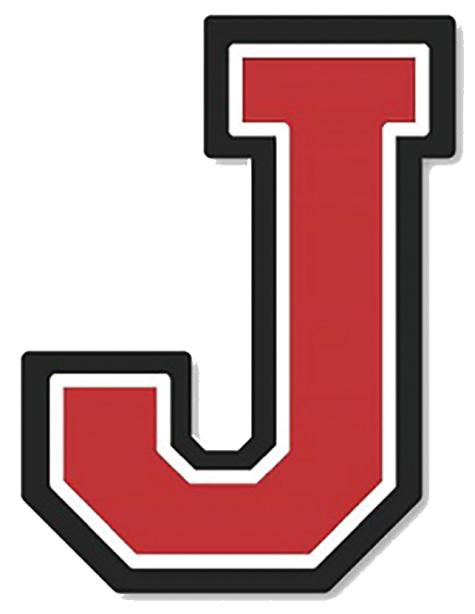
ACKSONVILLE
School District 117
Our Mission
Jacksonville School District 117 will provide an educational environment that promotes


values every student.








CERTIFIED STAFF VACANCIES:
Elementary Special Education Teacher (3 positions)
Agriculture Teacher at Jacksonville Middle School
Elementary ELL Teacher and ELL Teacher at Jacksonville Middle School
Special Education Teacher at Jacksonville Middle School (3 positions)
Science Teacher at Jacksonville High School
Special Education Teacher at Jacksonville High School (4 positions)
Math Teacher at Jacksonville Middle School
High School Counselor
Bus Drivers
Bus Monitors
Food Service Worker
Teachers: $125 per day for first 19 days – then $150 per day
Paraprofessionals: $112.50 per day
LPN Paraprofessionals: $20 per hour
Custodians: $17.00 per hour
Secretaries: $15.00 per hour
Nurses: $25.00 per hour
Food Service: $15.00 per hour
